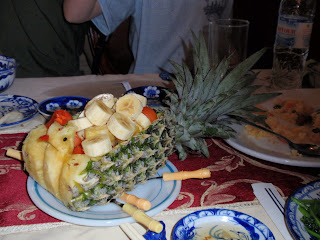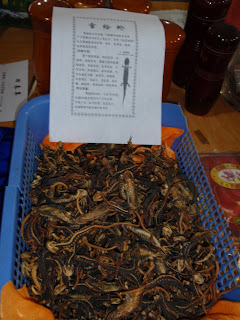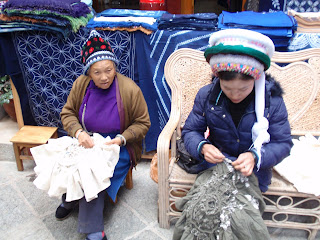
We arrived in South Viet Nam and took a trip down to the Meking River Delta area. We went out to a little island and got into some small sampans and were poled down a canal which led from one side of the island to the other.
To give us the "real" Vietnamese experience, we were given the pointed hats to wear while on the boat. I don't think Trent thought it was "cool" to wear a pointy hat, so he shed his and went bare headed.

This bridge was just completed and had only been open for a few days. It is actually three parts. This is the first one which leads to the island--out of sight on the left. Then the other two are on the far side and cannot be seen. n One is a tunnel so the boat traffic can go over the top of it. The Meking River is VERY wide. No one could tell us how many miles across, but we never got to see the other side.

Next we visited the tunnels where the Vietnamese and the Viet Cong in particular hid out during the war. They would come out of hiding, attack the US and then melt back into their holes. As you can see, the entry was small--but then the Vietnamese are small people--so it was difficult for the Americans to follow them--even if they could find the entryway.

Going on down. Kevin and some of the boys followed the tunnel for about half a mile. I went a short way and was glad to get out--dark, no light, shoulders brushed both sides, tunnel curved--very claustrophobic.

From hiding out to eating out. We had dellicious food in South Viet Nam. And it was presented in such artistic ways. I know this looks sort of gross in the picture, but the fish was actually quite tasty. We have learned to eat things that look back at us--not the heads or eyes though, just the meat.
In case you can't tell, this is fried rice shaped like a dragon. Not only did it look good, but it was quite tasty.
Here are a couple of ways to decorate with pineapple. This is a fruit bowl that looks like a chicken.
Here is a pineapple that looks like a rooster. And, yes, those are onion rings. They were quite tasty.
So now you have a taste of our winter trip--just in time for our spring trip. We leave this week for a 4 day cruise on the Yangtze River through the three gorges area. We are looking forward to that.















































